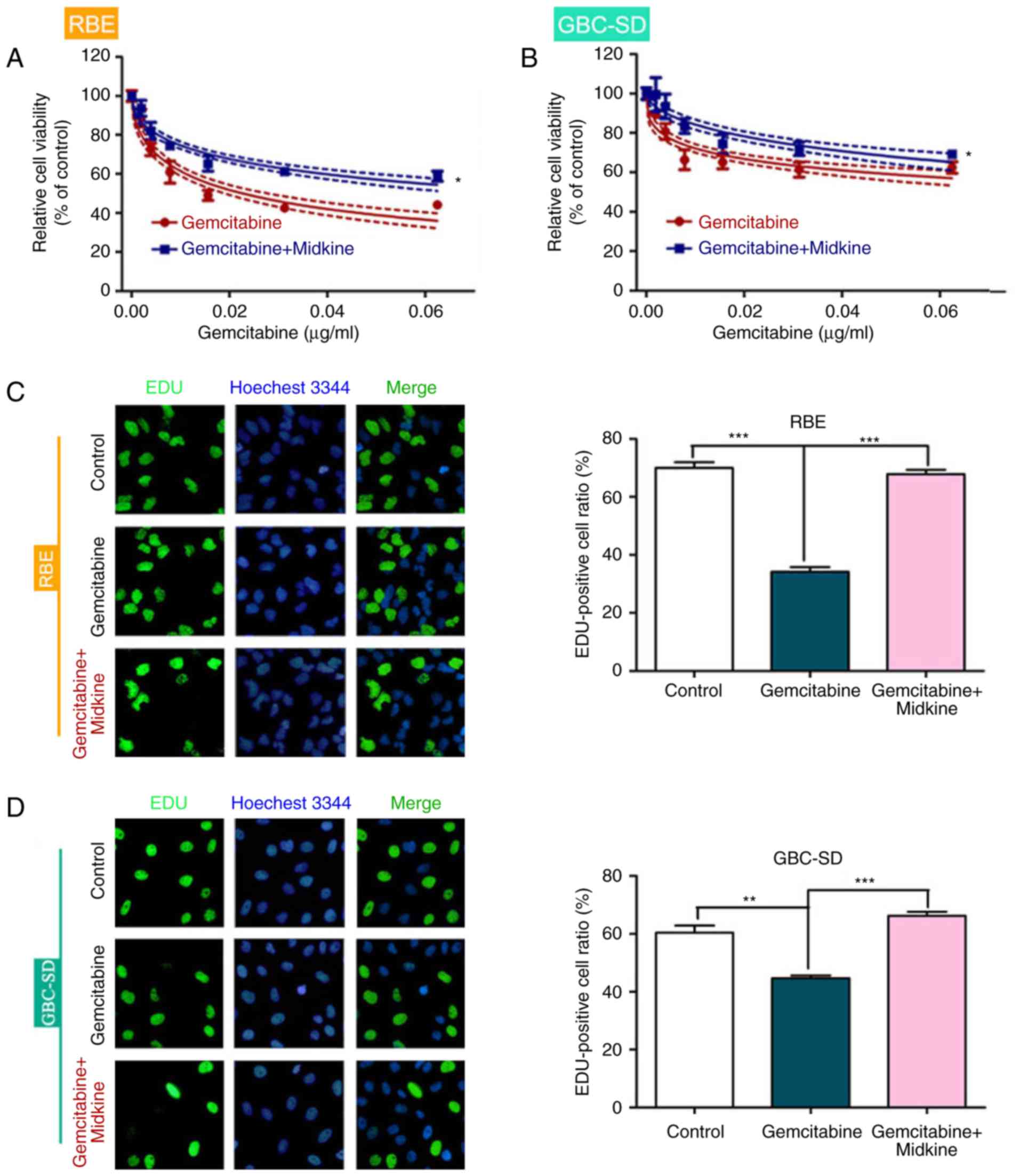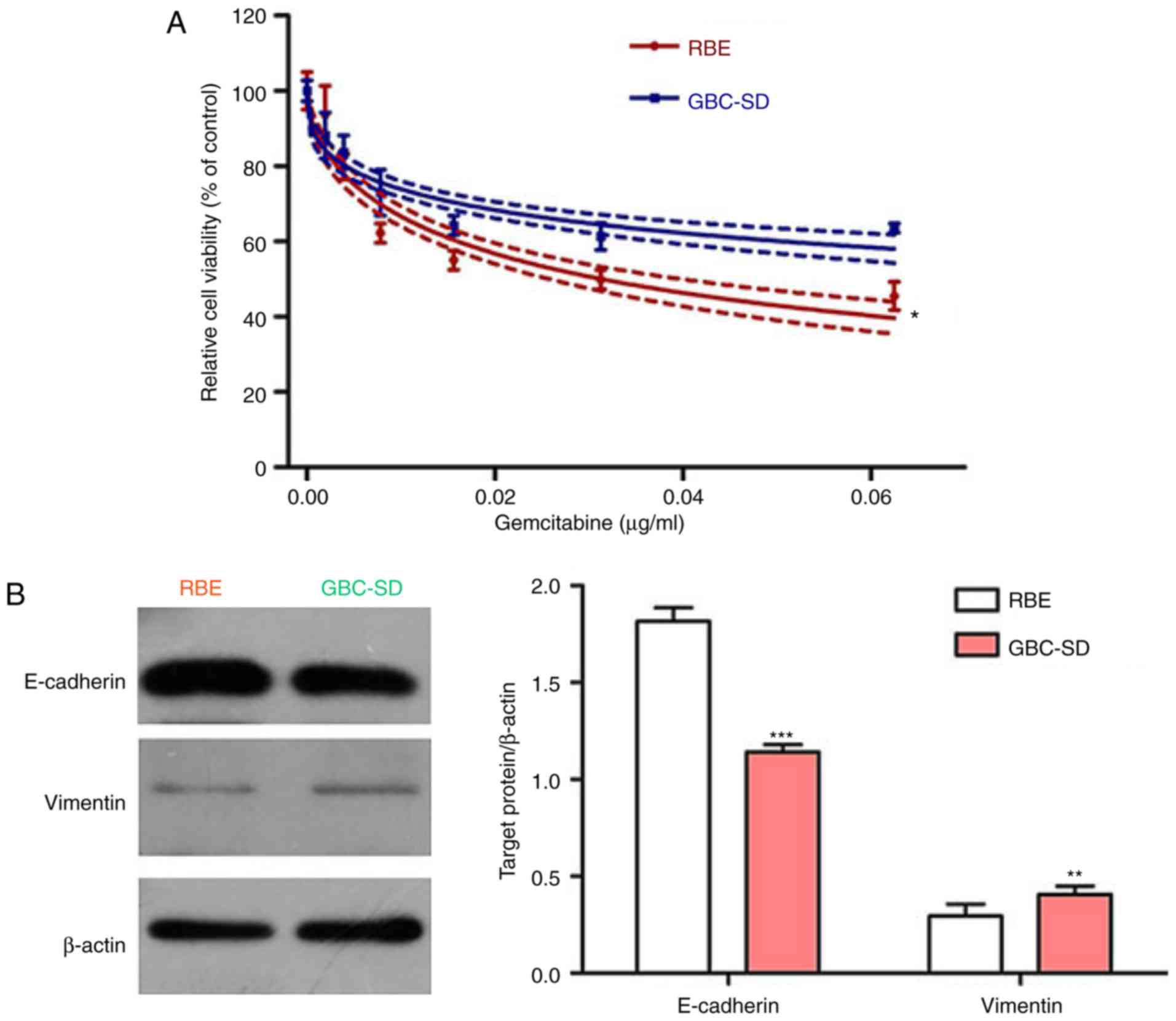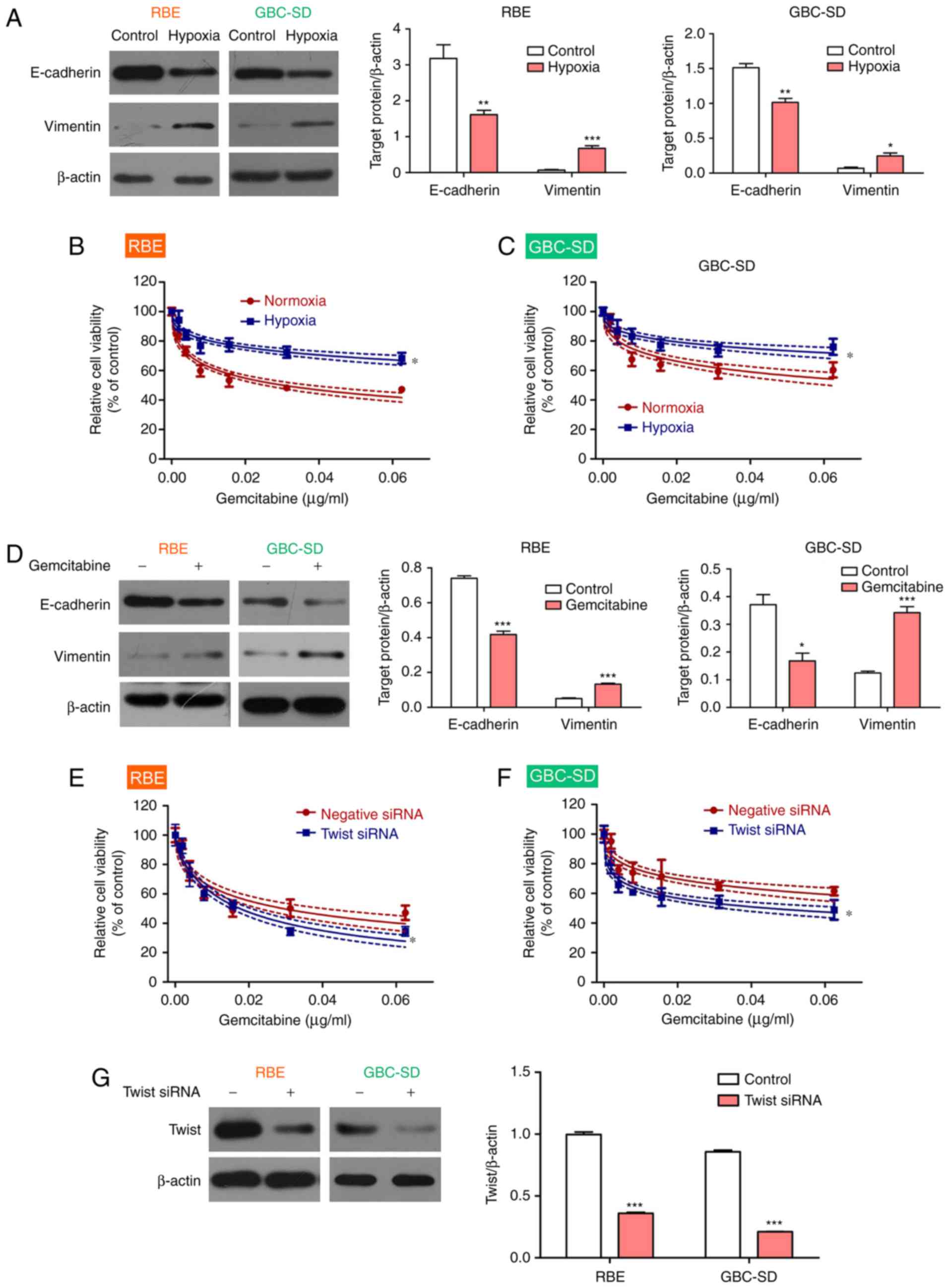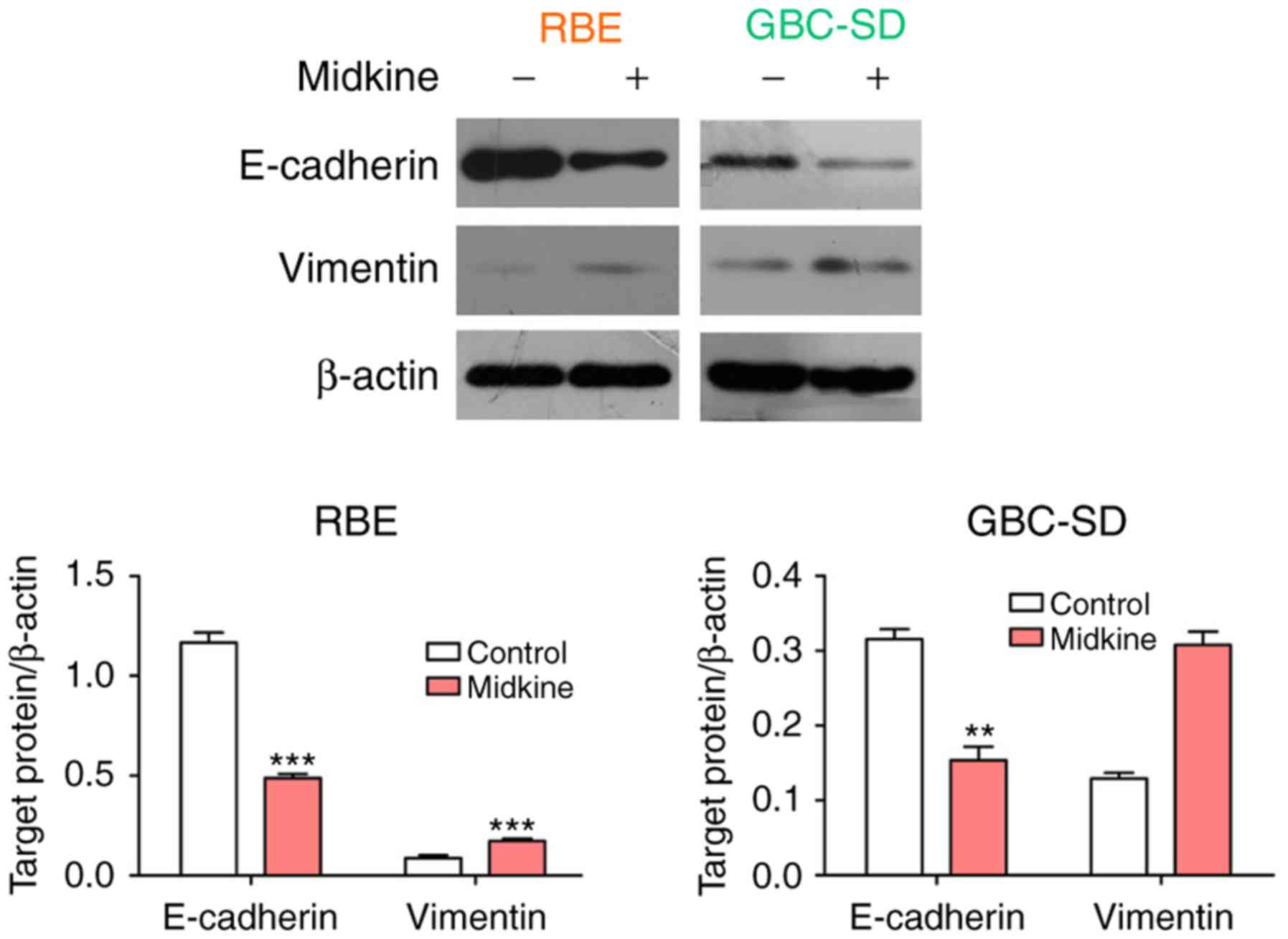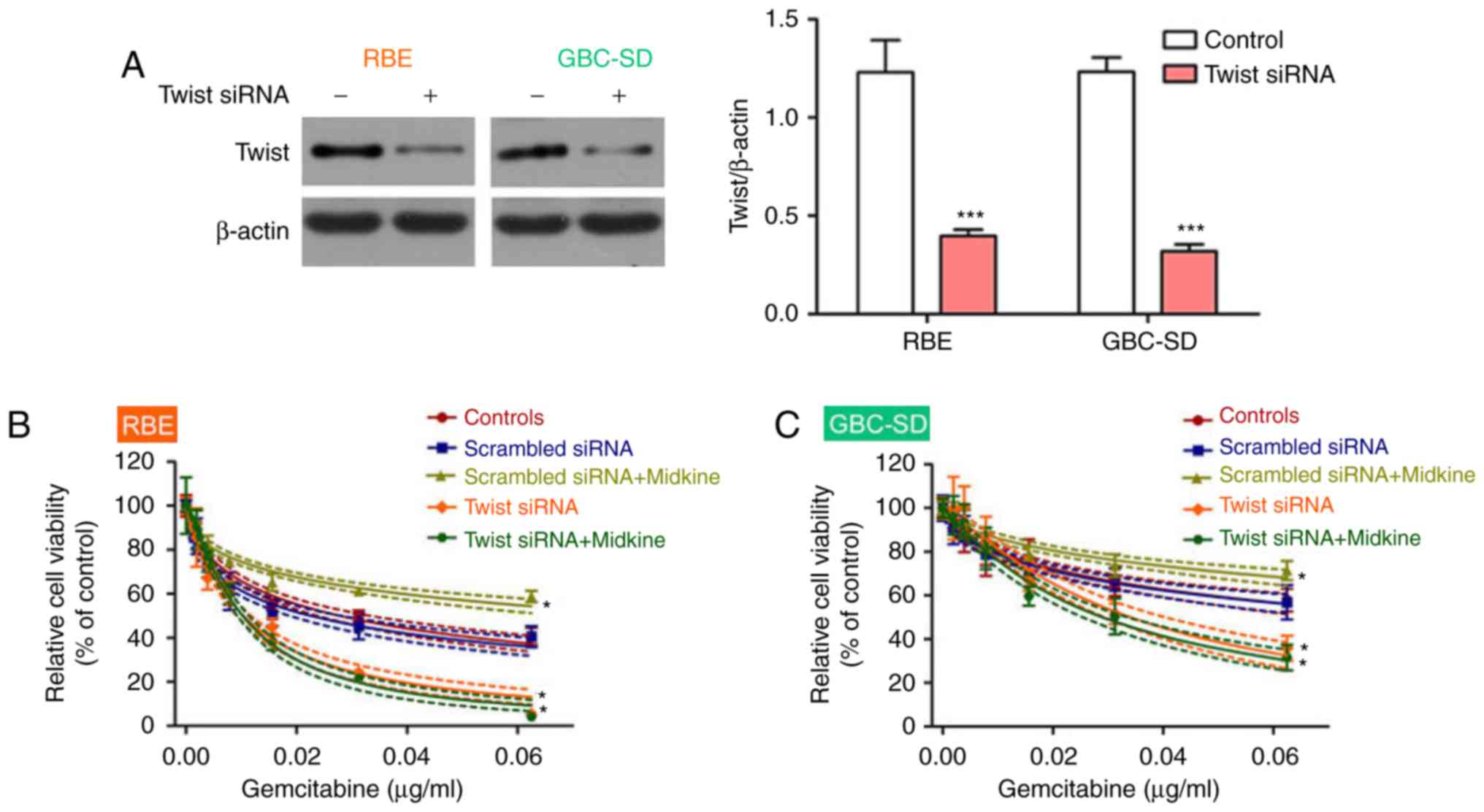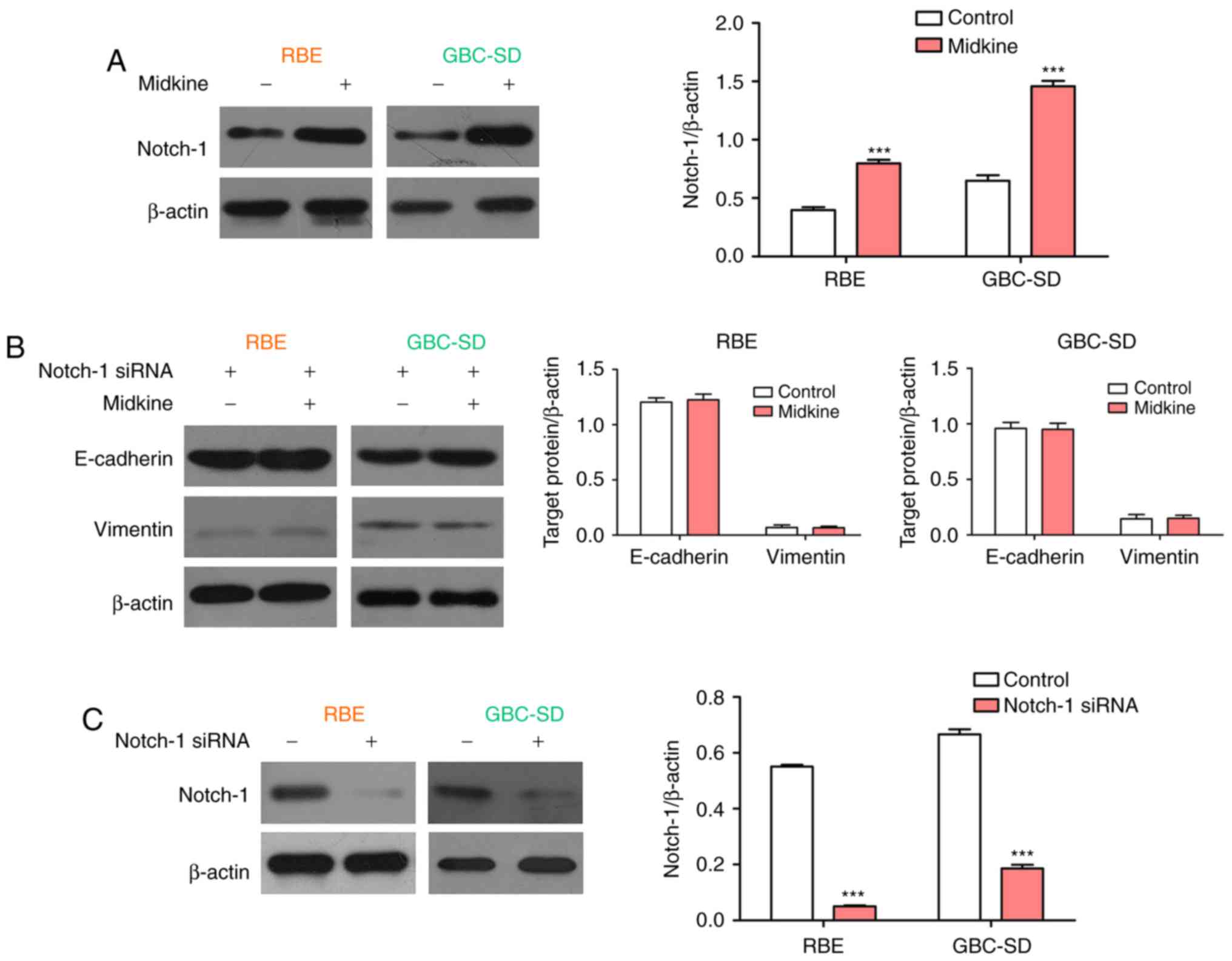Effect of midkine on gemcitabine resistance in biliary tract cancer
- Authors:
- Published online on: January 18, 2018 https://doi.org/10.3892/ijmm.2018.3399
- Pages: 2003-2011
-
Copyright: © Lu et al. This is an open access article distributed under the terms of Creative Commons Attribution License.
Abstract
Introduction
Biliary tract cancer (BTC) refers to a group of cancers of the biliary tract, including gallbladder cancer, cholangiocarcinoma of intrahepatic and extrahepatic bile ducts, and cancers of the ampulla and papilla of Vater (1,2). The incidence rate of BTC differs among geographic areas: It is high in Asia, Latin America and eastern European countries, while it is low in the US and certain western European countries (2). Complete resection has been considered the best treatment for BTC; however, most patients are ineligible for surgery due to its rapid progression and non-specific symptoms (3–5). Even patients who are treated with surgery have a poor prognosis.
Although surgery remains the only curative treatment option, chemotherapy prolongs the survival of patients with BTC (6,7). Among the chemotherapeutic drugs, gemcitabine and cisplatin have proven to be the most effective first-line drugs (8–10). However, drug resistance to gemcitabine limits its effect, and the median overall survival of patients with advanced BTC who receive chemotherapy is only ~1 year (11). Therefore, it is essential to explore the potential mechanism underlying the resistance of BTC to gemcitabine in order to enhance its effect and prolong patient survival.
Midkine (MDK), a heparin-binding growth factor, was first identified as a highly expressed factor involved in embryonic development (12). MDK has been reported to have important roles in the survival, growth and migration of cells, which may contribute to oncogenesis and tumor progression in numerous types of cancer (13–18). Several studies have demonstrated that MDK mediates drug resistance. Mirkin et al (19) employed a cytokine complementary DNA array to identify putative survival molecules in human neuroblastoma and osteosarcoma cells and identified MDK as a lead candidate responsible for doxorubicin resistance via regulation of the AKT pathway. Furthermore, Lorente et al (20) identified MDK as a pivotal factor involved in the resistance of glioma cells to the pro-autophagic and anti-tumoral action of tetrahydrocannabinol by regulation of the anaplastic lymphoma kinase receptor. Xu et al (21) proved that MDK, which activates AKT and extracellular signal-regulated kinase by phosphorylation, induced doxorubicin resistance in gastric cancer cells. Hu et al (22) indicated that MDK increased the drug-efflux ability in lymphoblastic leukemia, thereby having an important role in multidrug resistance. These results highlighted the fact that MDK may have an essential role in cancer chemotherapy resistance. However, the role of MDK in the drug resistance of BTC has remained largely elusive.
Epithelial to mesenchymal transition (EMT) is the process wherein epithelial cells lose their apical-basal polarity and cell-cell adhesion and transit to invasive mesenchymal cells. EMT cells exhibit decreased expression of epithelial genes (e.g., E-cadherin) and increased expression of mesenchymal genes (e.g., vimentin) (23). The link between EMT and drug resistance of cancer cells has been suggested in a previous study. Furthermore, increasing evidence has indicated that drug resistance of several cancer types, including lung (24), pancreatic (25), liver (26) and breast cancer (27), is frequently accompanied by EMT. In BTC, EMT involves the invasion and migration of BTC cells. However, evidence supporting the role of EMT in drug resistance of BTC has remained insufficient.
Therefore, the present study aimed to determine the association between MDK, EMT and gemcitabine resistance in BTC and explore the potential mechanisms underlying gemcitabine resistance.
Materials and methods
Cell culture and reagents
Two human BTC cell lines, RBE and GBC-SD, were purchased from the American Type Culture Collection (Manassas, VA, USA) and cultured according to the supplier's recommendation in RPMI-1640 medium (Gibco; Thermo Fisher Scientific, Inc., Waltham, MA, USA) supplemented with 10% fetal bovine serum (Gibco; Thermo Fisher Scientific, Inc.) and maintained at 37°C in a humidified atmosphere of air with 5% CO2. For hypoxia culture, cells were maintained at 37°C in a humidified atmosphere with 5% CO2, 1% O2 and 94% N2. MDK was from Sigma-Aldrich (cat. no. SRP3114; Merck KGaA, Darmstadt, Germany) and was used at a concentration of 50 ng/ml. Gemcitabine (cat. no. S1714) was purchased from Selleck Chemicals (Houston, TX, USA).
Cell viability assay
RBE and GBC-SD cells were seeded into 96-well microplates at a density of 5,000 cells/well and cultured with different concentrations of gemcitabine ranging from 0.00 to 0.06 µg/ml, MDK (50 ng/ml) or a combination of the two drugs for 48 h. Cell viability was detected using the Cell Counting Kit-8 (CCK-8) assay (Dojindo, Kumamoto, Japan) according to the manufacturer's protocol. In brief, 100 µl medium and 10 µl CCK-8 solution were added to microplates, and the cells were incubated for 2 h. The optical density at 450 nm was determined using a MRX II microplate reader (Dynex, Chantilly, VA, USA). Cell viability in each group was determined by comparison with untreated control cells.
Cell proliferation assay
Cell proliferation was analyzed by 5-ethynyl-2′-deoxyuridine (EdU) staining using the Click-iTEdU Imaging kit (Invitrogen; Thermo Fisher Scientific, Inc.) following the manufacturer's protocol. RBE or GBC-SD cells were treated with gemcitabine alone or a combination of gemcitabine (0.03136 µg/ml for RBE; 0.1433 µg/ml for GBC-SD) and MDK (50 ng/ml) for 48 h, and then exposed to 10 µMEdU for 2 h at 37°C. The cells were then fixed with 3.7% formaldehyde for 15 min at room temperature and treated with 0.5% Triton X-100 (Sangon Biotech, Shanghai, China) for 20 min at room temperature for permeabilization. After washing twice with PBS containing 3% bovine serum albumin, the cells were treated with 0.5 ml of Click-iT® reaction cocktail (Invitrogen; Thermo Fisher Scientific, Inc.) for 30 min in the dark. Subsequently, the cell DNA was stained with 1 ml 1X Hoechst 33342 (1:2,000 dilution) for 30 min. Finally, three random fields of view per slide were selected under a fluorescence microscope (Olympus, Tokyo, Japan), and the number of proliferative (EdU-positive) cells was counted.
Cell transfection for RNA interference
Human Twist small interfering RNA (siRNA) was synthesized by Shanghai GeneChem Co., Ltd. (Shanghai, China). The human Twist siRNA sequence was as follows: Twist1, 5′-GGUGUCUAAAUGCAUUCAUTT-3′ and 5′-AUGAAUGCAUUUAGACACCTT-3′; Notch1, 5′-CCAACCCUGUCAAUGGCAATT-3′ and 5′-UUGCCAUUGACAGGGUUGGTT-3′; Scrambled siRNA, 5′-UUCUCCGAACGUGUCACGUTT-3′ and 5′-ACGUGACACGUUCGGAGAATT-3′. The transfection was performed by using Lipofectamine 2000 (Invitrogen; Thermo Fisher Scientific, Inc.) according to the manufacturer's protocol.
Western blot analysis
The interference efficiency of Twist siRNA and its effect on the expression of various proteins was determined by western blot analysis (28). The following antibodies were used: Anti-E-cadherin (cat. no. 3195), anti-vimentin (cat. no. 5741), anti-Twist (cat. no. 46702), anti-β-actin (cat. no. 8457) (all at 1:1,000 dilution; Cell Signaling Technology, Inc., Danvers, MA, USA) and anti-Notch-1 (cat. no. ab8925; 1:1,000 dilution; Abcam, Cambridge, UK). The corresponding secondary antibodies conjugated to horseradish peroxidase (cat. no. ab98489; 1:2,000 dilution) were obtained from Abcam. The grey value was analyzed by QuantityOnev. 4.62 software (Bio-Rad Laboratories, Inc., Hercules, CA, USA).
Statistical analysis
Three independent experiments were performed for each experiment. Experimental data were expressed as the mean ± standard deviation. Analyses were performed using GraphPad Prism 5 (GraphPad Software, Inc., La Jolla, CA, USA). Comparisons among datasets were performed by using one-way analysis of variance followed by Tukey's post hoc test or a unpaired Student's t-test. P<0.05 was considered to indicate a statistically significant difference.
Results
MDK induces gemcitabine resistance in BTC cells
To determine whether MDK is involved in gemcitabine resistance of BTC, the effect of MDK on BTC cell viability was evaluated in the presence of different concentrations of gemcitabine. BTC cells exhibited higher cell viability after gemcitabine + MDK treatment than cells treated with gemcitabine alone (Fig. 1A and B). In addition, the EdU assay indicated that BTC cells had increased proliferation in the presence of gemcitabine and MDK compared with gemcitabine alone, which suggests that MDK induces gemcitabine resistance in BTC (Fig. 1C and D).
EMT is involved in gemcitabine resistance of BTC cells
The EMT is known to be associated with chemoresistance of cancers, and MDK was reported to induce EMT in several cancer types (29–31). Thus, the present study hypothesized that EMT may be involved in gemcitabine resistance in BTC and that MDK may promote gemcitabine resistance in BTC by regulating the EMT pathway. To prove this hypothesis, the efficiency of gemcitabine on the two BTC cell lines was first examined. The CCK-8 assay indicated that gemcitabine effectively inhibited the viability of BTC cells in a concentration-dependent manner. Of note, the BTC cell line RBE was more sensitive to gemcitabine than the GBC-SD cell line (Fig. 2A). Subsequently, the expression of the epithelial marker E-cadherin and the mesenchymal marker vimentin was assessed in these two cell lines, revealing that the cell line RBE had high E-cadherin levels, but low vimentin levels, whereas the opposite results were observed in the GBC-SD cell line (Fig. 2B). Accordingly, the present results indicate that EMT may be involved in gemcitabine resistance in BTC.
To confirm this result, the BTC cell lines were exposed to hypoxic conditions to induce EMT, as reported previously (32,33). The results demonstrated that hypoxia upregulated the expression of vimentin and downregulated the expression of E-cadherin in BTC cell lines, thereby promoting EMT (Fig. 3A). As expected, BTC cell viability increased in the presence of gemcitabine under hypoxic conditions compared with that under normoxic conditions (Fig. 3B and C). In addition, gemcitabine treatment led to an upregulation of the expression of vimentin and a downregulation of the expression of E-cadherin in the BTC cell lines under normoxia conditions (Fig. 3D). To confirm the role of the EMT in gemcitabine resistance, Twist, a key regulator of EMT (34), was knocked down to block EMT in BTC cell lines. The results demonstrated that the BTC cell lines became more sensitive to gemcitabine after Twist inhibition (Fig. 3E and F). Interference efficiency of Twist1 was measured using western blot analysis (Fig. 3G). Therefore, the present results indicated that gemcitabine resistance in BTC may be mediated via the EMT.
MDK mediates gemcitabine resistance in BTC cells by regulating EMT
To further prove the abovementioned hypothesis, the association between MDK and EMT in gemcitabine resistance was examined. First, the expression of E-cadherin and vimentin was detected in the two BTC cell lines cultured in the presence of MDK. The results indicated that MDK treatment led to a significant upregulation of vimentin expression and a downregulation of E-cadherin expression in BTC cell lines (Fig. 4). Thereafter, the efficiency of MDK to induce gemcitabine resistance was examined after EMT blockage. To block EMT, Twist, the key molecule in the EMT pathway, was inhibited using siRNA. The knockdown efficiency of Twist siRNA was confirmed by western blot (Fig. 5A). As expected, cells transfected with scrambled siRNA were more sensitive to treatment with gemcitabine compared with those in the MDK+scrambled siRNA group, and after EMT inhibition with Twist siRNA, the effect of MDK to induce gemcitabine resistance in BTC cells was lost (Fig. 5B and C). Hence, the present results proved the hypothesis that MDK promotes gemcitabine resistance in BTC by regulating EMT.
Midkine induces EMT by upregulating Notch-1 expression
The Notch pathway has a significant role in EMT of cancer cells (35,36), and Notch-1 activation has been reported to be linked to acquired chemoresistance in several cancer types (37–40). Therefore, the role of MDK in Notch-1 expression was then examined in the present study. The western blot results demonstrated that MDK significantly promoted the expression of Notch-1 in BTC cell lines (Fig. 6A). Subsequently, the expression of E-cadherin and vimentin was examined in BTC cells treated with Notch-1 siRNA or a combination of Notch-1 siRNA and MDK. The results indicated that siRNA-mediated knockdown of Notch-1 completely abolished the regulatory effect of MDK on the expression of E-cadherin and vimentin in BTC cells (Fig. 6B). The interference efficiency of Notch1 was detected by western blot analysis (Fig. 6C). These results indicate that Notch-1 is a mediator in MDK-induced EMT.
Discussion
Chemotherapy has been considered an effective adjuvant therapy for BTC; however, drug resistance limits the efficiency of chemotherapy (7,41). Therefore, further studies are required to determine the potential mechanism of drug resistance in BTC. In the present study, MDK was demonstrated to induce drug resistance in BTC via induction of the EMT through regulating the expression of the Notch-1 protein.
MDK is a growth factor that was first identified as a mediator of retinoic acid-induced differentiation (12). Further studies indicated that it was associated with drug resistance. Mirkin et al (19) proved that MDK was secreted from drug-resistant cells and protected the neighboring drug-sensitive cells from the toxicity of doxorubicin. Kang et al (42) identified >250 differentially expressed genes in 5-fluorouracil-, cisplatin- or doxorubicin-resistant gastric cancer cell lines by microarray analysis and determined that MDK was overexpressed in all drug-resistant cell lines. Qi et al (43) reported that MDK protected murine kidney cells and cultured Wilms' tumor cells from cisplatin-induced apoptotic cell death by upregulating the expression of B-cell lymphoma 2. Regarding BTC, MDK was upregulated in intrahepatic cholangiocarcinoma. However, little is known regarding the effect of MDK on the drug resistance of BTC. Therefore, the present study assessed this aspect and proved that MDK induced gemcitabine resistance in BTC.
The EMT is known to be involved in cancer drug resistance via various functions, including regulation of cancer cell stemness, overexpression of ATP binding cassette transporters, inhibition of epithelial growth factor receptor tyrosine kinase inhibitor-induced apoptosis and alteration of the tumor microenvironment (44). Previous studies have reported that replication stress-induced MDK expression activates Notch-2, which drives EMT and chemoresistance in pancreatic cancer (30). The MDK-induced crosstalk of Notch2/Janus kinase 2/signal transducer and activator of transcription 3 signaling pathways regulates cell plasticity and motility, thereby contributing to EMT in human keratinocytes (31). In lung adenocarcinoma, estrogen receptor β-mediated estradiol enhanced MDK expression and increased EMT (29). Considering these previous studies, it was hypothesized that MDK may mediate gemcitabine resistance in BTC cells by regulating EMT. To the best of our knowledge, the present study was the first to provide in vitro evidence to prove this hypothesis.
The Notch signaling pathway has critical roles in the development and progression of human cancers, as this pathway is critically involved in numerous cellular processes, including proliferation, survival, apoptosis, migration, invasion, angiogenesis and metastasis. Emerging evidence suggests that Notch regulates EMT, leading to tumor invasion and metastasis (35,36,45–49). Notch-1 has been reported to promote EMT in several cancer types (50–52). Although the association between MDK and Notch-2 is well known, the association between MDK and Notch-1 has remained elusive. In the present study, MDK was demonstrated to upregulate Notch-1 expression and it was revealed that MDK-induced EMT was mediated by Notch-1. These results highlight the role of Notch-1 in MDK-induced EMT.
To the best of our knowledge, the present study was the first to provide evidence that MDK enhances gemcitabine resistance in BTC cells via the Notch-1/EMT axis. Therefore, targeting MDK or blocking/reversing EMT prior to or during chemotherapy may force chemoresistant cells to revert to sensitive cells and may thus provide a tremendous benefit to patients with advanced chemoresistant cancers. Further study is required to understand the precise molecular mechanisms underlying gemcitabine resistance in BTC.
Acknowledgments
This study was financially supported by the National Natural Science Foundation of China (grant no. 81501830), the Zhejiang Province Natural Science Foundation of China (grant nos. LY16H160041 and LY16H160041) and the Huzhou Science and Technology Project (grant nos. 2014GZ11 and 2015GZ16).
Notes
[1] Competing interests
The authors declare that they have no competing interests.
References
|
Hennedige TP, Neo WT and Venkatesh SK: Imaging of malignancies of the biliary tract-an update. Cancer Imaging. 14:142014. | |
|
Randi G, Malvezzi M, Levi F, Ferlay J, Negri E, Franceschi S and La Vecchia C: Epidemiology of biliary tract cancers: An update. Ann Oncol. 20:146–159. 2009. View Article : Google Scholar | |
|
Horgan AM, Amir E, Walter T and Knox JJ: Adjuvant therapy in the treatment of biliary tract cancer: A systematic review and meta-analysis. J Clin Oncol. 30:1934–1940. 2012. View Article : Google Scholar : PubMed/NCBI | |
|
Hezel AF and Zhu AX: Systemic therapy for biliary tract cancers. Oncologist. 13:415–423. 2008. View Article : Google Scholar : PubMed/NCBI | |
|
Khan SA, Davidson BR, Goldin RD, Heaton N, Karani J, Pereira SP, Rosenberg WM, Tait P, Taylor-Robinson SD, Thillainayagam AV, et al: Guidelines for the diagnosis and treatment of cholangiocarcinoma: An update. Gut. 61:1657–1669. 2012. View Article : Google Scholar : PubMed/NCBI | |
|
Goyal L, Chong DQ, Duda DG and Zhu AX: Chemotherapy and antiangiogenics in biliary tract cancer. Lancet Oncol. 16:882–883. 2015. View Article : Google Scholar : PubMed/NCBI | |
|
Ghosn M, Kourie HR, El Rassy E, Chebib R, El Karak F, Hanna C and Nasr D: Optimum chemotherapy for the management of advanced biliary tract cancer. World J Gastroenterol. 21:4121–4125. 2015. View Article : Google Scholar : PubMed/NCBI | |
|
Park K, Kim KP, Park S and Chang HM: Comparison of gemcitabine plus cisplatin versus capecitabine plus cisplatin as first-line chemotherapy for advanced biliary tract cancer. Asia Pac J Clin Oncol. 13:13–20. 2017. View Article : Google Scholar | |
|
Stein A, Arnold D, Bridgewater J, Goldstein D, Jensen LH, Klümpen HJ, Lohse AW, Nashan B, Primrose J, Schrum S, et al: Adjuvant chemotherapy with gemcitabine and cisplatin compared to observation after curative intent resection of cholangiocarcinoma and muscle invasive gallbladder carcinoma (ACTICCA-1 trial)-a randomized, multidisciplinary, multinational phase III trial. BMC Cancer. 15:5642015. View Article : Google Scholar | |
|
Lamarca A, Benafif S, Ross P, Bridgewater J and Valle JW: Cisplatin and gemcitabine in patients with advanced biliary tract cancer (ABC) and persistent jaundice despite optimal stenting: Effective intervention in patients with luminal disease. Eur J Cancer. 51:1694–1703. 2015. View Article : Google Scholar : PubMed/NCBI | |
|
Yonemoto N, Furuse J, Okusaka T, Yamao K, Funakoshi A, Ohkawa S, Boku N, Tanaka K, Nagase M, Saisho H and Sato T: A multi-center retrospective analysis of survival benefits of chemotherapy for unresectable biliary tract cancer. Jpn J Clin Oncol. 37:843–851. 2007. View Article : Google Scholar : PubMed/NCBI | |
|
Böhlen P and Kovesdi I: HBNF and MK members of a novel gene family of heparin-binding proteins with potential roles in embryogenesis and brain function. Prog Growth Factor Res. 3:143–157. 1991. View Article : Google Scholar | |
|
Vu Van D, Heberling U, Wirth MP and Fuessel S: Validation of the diagnostic utility of urinary midkine for the detection of bladder cancer. Oncol Lett. 12:3143–3152. 2016. View Article : Google Scholar : PubMed/NCBI | |
|
Edfeldt K, Daskalakis K, Bäcklin C, Norlén O, Tiensuu Janson E, Westin G, Hellman P and Stålberg P: DcR3, TFF3 and midkine are novel serum biomarkers in small intestinal neuroendocrine tumors. Neuroendocrinology. 105:170–181. 2017. View Article : Google Scholar | |
|
Krzystek-Korpacka M, Gorska S, Diakowska D, Kapturkiewicz B, Podkowik M, Gamian A and Bednarz-Misa I: Midkine is up-regulated in both cancerous and inflamed bowel, reflecting lymph node metastasis in colorectal cancer and clinical activity of ulcerative colitis. Cytokine. 89:68–75. 2017. View Article : Google Scholar | |
|
Vongsuvanh R, van der Poorten D, Iseli T, Strasser SI, McCaughan GW and George J: Midkine increases diagnostic yield in AFP negative and NASH-related hepatocellular carcinoma. PLoS One. 11:e01558002016. View Article : Google Scholar : PubMed/NCBI | |
|
Yamashita T, Shimada H, Tanaka S, Araki K, Tomifuji M, Mizokami D, Tanaka N, Kamide D, Miyagawa Y, Suzuki H, et al: Serum midkine as a biomarker for malignancy, prognosis, and chemosensitivity in head and neck squamous cell carcinoma. Cancer Med. 5:415–425. 2016. View Article : Google Scholar : PubMed/NCBI | |
|
Yao J, Li WY and Gao SG: The advances of Midkine with peripheral invasion in pancreatic cancer. Am J Cancer Res. 5:2912–2917. 2015.PubMed/NCBI | |
|
Mirkin BL, Clark S, Zheng X, Chu F, White BD, Greene M and Rebbaa A: Identification of midkine as a mediator for intercellular transfer of drug resistance. Oncogene. 24:4965–4974. 2005. View Article : Google Scholar : PubMed/NCBI | |
|
Lorente M, Torres S, Salazar M, Carracedo A, Hernández-Tiedra S, Rodríguez-Fornés F, García-Taboada E, Meléndez B, Mollejo M, Campos-Martín Y, et al: Stimulation of ALK by the growth factor midkine renders glioma cells resistant to autophagy-mediated cell death. Autophagy. 7:1071–1073. 2011. View Article : Google Scholar : PubMed/NCBI | |
|
Xu YY, Mao XY, Song YX, Zhao F, Wang ZN, Zhang WX, Xu HM and Jin F: Midkine confers Adriamycin resistance in human gastric cancer cells. Tumor Biol. 33:1543–1548. 2012. View Article : Google Scholar | |
|
Hu R, Yan Y, Li Q, Lin Y, Jin W, Li H, Lu Y and Pang T: Increased drug efflux along with midkine gene high expression in childhood B-lineage acute lymphoblastic leukemia cells. Int J Hematol. 92:105–110. 2010. View Article : Google Scholar : PubMed/NCBI | |
|
Vaquero J, Guedj N, Clapéron A, Nguyen Ho-Bouldoires TH, Paradis V and Fouassier L: Epithelial-mesenchymal transition in cholangiocarcinoma: From clinical evidence to regulatory networks. J Hepatol. 66:424–441. 2017. View Article : Google Scholar | |
|
Sung WJ, Kim H and Park KK: The biological role of epithelial-mesenchymal transition in lung cancer (Review). Oncol Rep. 36:1199–1206. 2016. View Article : Google Scholar : PubMed/NCBI | |
|
Nomura A, Majumder K, Giri B, Dauer P, Dudeja V, Roy S, Banerjee S and Saluja AK: Inhibition of NF-kappa B pathway leads to deregulation of epithelial-mesenchymal transition and neural invasion in pancreatic cancer. Lab Invest. 96:1268–1278. 2016. View Article : Google Scholar : PubMed/NCBI | |
|
Kim HS, Lee KS, Bae HJ, Eun JW, Shen Q, Park SJ, Shin WC, Yang HD, Park M, Park WS, et al: MicroRNA-31 functions as a tumor suppressor by regulating cell cycle and epithelial-mesenchymal transition regulatory proteins in liver cancer. Oncotarget. 6:8089–8102. 2015.PubMed/NCBI | |
|
Zhang X, Liu X, Luo J, Xiao W, Ye X, Chen M, Li Y and Zhang GJ: Notch3 inhibits epithelial-mesenchymal transition by activating Kibra-mediated Hippo/YAP signaling in breast cancer epithelial cells. Oncogenesis. 5:e2692016. View Article : Google Scholar : PubMed/NCBI | |
|
Xu G, Shao G, Pan Q, Sun L, Zheng D and Li M: MicroRNA-9 regulates non-small cell lung cancer cell invasion and migration by targeting eukaryotic translation initiation factor 5A2. Am J Transl Res. 9:478–488. 2017.PubMed/NCBI | |
|
Zhao G, Nie Y, Lv M, He L, Wang T and Hou Y: ERβ-mediated estradiol enhances epithelial mesenchymal transition of lung adenocarcinoma through increasing transcription of midkine. Mol Endocrinol. 26:1304–1315. 2012. View Article : Google Scholar : PubMed/NCBI | |
|
Güngör C, Zander H, Effenberger KE, Vashist YK, Kalinina T, Izbicki JR, Yekebas E and Bockhorn M: Notch signaling activated by replication stress-induced expression of midkine drives epithelial-mesenchymal transition and chemoresistance in pancreatic cancer. Cancer Res. 71:5009–5019. 2011. View Article : Google Scholar : PubMed/NCBI | |
|
Huang Y, Hoque MO, Wu F, Trink B, Sidransky D and Ratovitski EA: Midkine induces epithelial-mesenchymal transition through Notch2/Jak2-Stat3 signaling in human keratinocytes. Cell Cycle. 7:1613–1622. 2008. View Article : Google Scholar : PubMed/NCBI | |
|
Chen S, Chen JZ, Zhang JQ, Chen HX, Yan ML, Huang L, Tian YF, Chen YL and Wang YD: Hypoxia induces TWIST-activated epithelial-mesenchymal transition and proliferation of pancreatic cancer cells in vitro and in nude mice. Cancer Lett. 383:73–84. 2016. View Article : Google Scholar : PubMed/NCBI | |
|
Yang J, Zhang X, Zhang Y, Zhu D, Zhang L, Li Y, Zhu Y, Li D and Zhou J: HIF-2α promotes epithelial-mesenchymal transition through regulating Twist2 binding to the promoter of E-cadherin in pancreatic cancer. J Exp Clin Cancer Res. 35:262016. View Article : Google Scholar | |
|
Lee JY and Kong G: Roles and epigenetic regulation of epithelial-mesenchymal transition and its transcription factors in cancer initiation and progression. Cell Mol Life Sci. 73:4643–4660. 2016. View Article : Google Scholar : PubMed/NCBI | |
|
Espinoza I, Pochampally R, Xing F, Watabe K and Miele L: Notch signaling: Targeting cancer stem cells and epithelial-to-mesenchymal transition. Onco Targets Ther. 6:1249–1259. 2013.PubMed/NCBI | |
|
Ma J, Xia J, Miele L, Sarkar FH and Wang Z: Notch signaling pathway in pancreatic cancer progression. Pancreat Disord Ther. 3(pii): 10001142013. View Article : Google Scholar : PubMed/NCBI | |
|
Liu H, Yin Y, Hu Y, Feng Y, Bian Z, Yao S, Li M, You Q and Huang Z: miR-139 5p sensitizes colorectal cancer cells to 5-fluorouracil by targeting NOTCH-1. Pathol Res Pract. 212:643–649. 2016. View Article : Google Scholar : PubMed/NCBI | |
|
Mirone G, Perna S, Shukla A and Marfe G: Involvement of Notch-1 in resistance to regorafenib in colon cancer cells. J Cell Physiol. 231:1097–1105. 2016. View Article : Google Scholar | |
|
Xie M, He CS, Wei SH and Zhang L: Notch-1 contributes to epidermal growth factor receptor tyrosine kinase inhibitor acquired resistance in non-small cell lung cancer in vitro and in vivo. Eur J Cancer. 49:3559–3572. 2013. View Article : Google Scholar : PubMed/NCBI | |
|
Osipo C, Patel P, Rizzo P, Clementz AG, Hao L, Golde TE and Miele L: ErbB-2 inhibition activates Notch-1 and sensitizes breast cancer cells to a gamma-secretase inhibitor. Oncogene. 27:5019–5032. 2008. View Article : Google Scholar : PubMed/NCBI | |
|
Oyasiji T, Zhang J, Kuvshinoff B, Iyer R and Hochwald SN: Molecular targets in biliary carcinogenesis and implications for therapy. Oncologist. 20:742–751. 2015. View Article : Google Scholar : PubMed/NCBI | |
|
Kang HC, Kim IJ, Park JH, Shin Y, Ku JL, Jung MS, Yoo BC, Kim HK and Park JG: Identification of genes with differential expression in acquired drug-resistant gastric cancer cells using high-density oligonucleotide microarrays. Clin Cancer Res. 10:272–284. 2004. View Article : Google Scholar : PubMed/NCBI | |
|
Qi M, Ikematsu S, Ichihara-Tanaka K, Sakuma S, Muramatsu T and Kadomatsu K: Midkine rescues Wilms' tumor cells from cisplatin-induced apoptosis: Regulation of Bcl-2 expression by Midkine. J Biochem. 127:269–277. 2000. View Article : Google Scholar : PubMed/NCBI | |
|
Du B and Shim JS: Targeting epithelial-mesenchymal transition (EMT) to overcome drug resistance in cancer. Molecules. 21(pii): E9652016. View Article : Google Scholar : PubMed/NCBI | |
|
Brabletz S, Bajdak K, Meidhof S, Burk U, Niedermann G, Firat E, Wellner U, Dimmler A, Faller G, Schubert J and Brabletz T: The ZEB1/miR-200 feedback loop controls Notch signalling in cancer cells. EMBO J. 30:770–782. 2011. View Article : Google Scholar : PubMed/NCBI | |
|
Espinoza I and Miele L: Deadly crosstalk: Notch signaling at the intersection of EMT and cancer stem cells. Cancer Lett. 341:41–45. 2013. View Article : Google Scholar : PubMed/NCBI | |
|
Hu YY, Zheng MH, Zhang R, Liang YM and Han H: Notch signaling pathway and cancer metastasis. Adv Exp Med Biol. 727:186–198. 2012. View Article : Google Scholar : PubMed/NCBI | |
|
Vinson KE, George DC, Fender AW, Bertrand FE and Sigounas G: The Notch pathway in colorectal cancer. Int J Cancer. 138:1835–1842. 2016. View Article : Google Scholar | |
|
Wang Z, Li Y, Banerjee S and Sarkar FH: Emerging role of Notch in stem cells and cancer. Cancer Lett. 279:8–12. 2009. View Article : Google Scholar : | |
|
Bao B, Wang Z, Ali S, Kong D, Li Y, Ahmad A, Banerjee S, Azmi AS, Miele L and Sarkar FH: Notch-1 induces epithelial-mesenchymal transition consistent with cancer stem cell phenotype in pancreatic cancer cells. Cancer Lett. 307:26–36. 2011. View Article : Google Scholar : PubMed/NCBI | |
|
Fender AW, Nutter JM, Fitzgerald TL, Bertrand FE and Sigounas G: Notch-1 promotes stemness and epithelial to mesenchymal transition in colorectal cancer. J Cell Biochem. 116:2517–2527. 2015. View Article : Google Scholar : PubMed/NCBI | |
|
Hao L, Rizzo P, Osipo C, Pannuti A, Wyatt D, Cheung LW, Sonenshein G, Osborne BA and Miele L: Notch-1 activates estrogen receptor-alpha-dependent transcription via IKK alpha in breast cancer cells. Oncogene. 29:201–213. 2010. View Article : Google Scholar |



